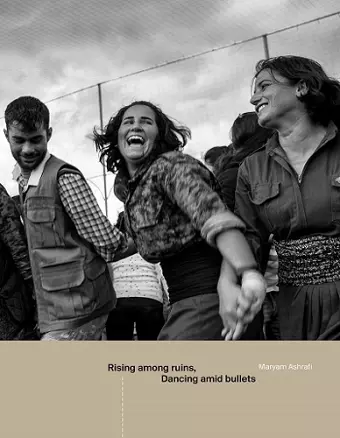Rising Among Ruins, Dancing Amid Bullets
Carol Mann author Kamran Matin author Maryam Ashrafi author Allan Kaval author Mylène Sauloy author
Format:Hardback
Publisher:Hemeria
Published:15th Dec '21
Should be back in stock very soon

Maryam Ashrafi is a social documentary photographer who believes in long term projects, she chooses to stay behind the front lines and observe the daily lives of combatants, which includes a lot of waiting around. She is above all involved in documenting the everyday life on the Kurdish front. Her work puts a face on a widely commented war which remains, from afar, perceived mainly by the West in terms of the number of refugees. Maryam documents the war in her own way, stressing its complexities and the actual building of a new social model based on equality where women occupy the same roles as men, which is remarkable in this area of the world. This is why, over the years, she has returned to the same places, from Kobane to Tabqa, to show the unique power of the resilience of the population and the will to live and change. «The struggle of the Kurdish people and their fight for freedom and fundamental rights have not come to an end, and therefore this book cannot portray all of their journeys, nor shall I stop documenting what is still to come. Yet I believe, as a witness, I owe it to history and to those I have met for sharing some of these images in this book to show part of their journey to freedom and equality», Maryam believes. The book is built on the chronology of the events as documented by Maryam Ashrafi, to understand the evolution of the conflict and its consequences on the populations and their living environment. Photographer James Nachtwey once made a point about such war photographs shown in museums, or in a book; it is "a space for reflection on the universality of the dramas that humanity is going through in its entirety". During her travels, Maryam Ashrafi has created a body of images which highlight very important topics as they are an immediate consequence of war, from the sheer destruction to the refugee camps, as they evoke the foundations of the culture and the identity of the Kurdish people - the ceremonies in honour of martyrs, dances around fires, New Year celebrations etc. Finally, Maryam Ashrafi’s work is also about empathy and about invisible wounds; it is obvious that...
“There is another face to war. Before the fighting begins, the men and women who will take part in the combat face a long wait behind the front. And once the firing has stopped, the silence of the ruins remains. These moments of time and these places, away from the din of weapons, where people are not yet dying or are dying no longer, are also part of war. War is as present here as on the battlefield. It is here that it leaves its mark on bodies, becomes embedded in the landscape, changes men and women and sticks to children’s steps. Maryam Ashrafi started roaming this liminal world, between death that lurks and life that goes on, during her first visit to Kurdistan in 2012, and she has continued to do so ever since the conflict between Kurdish forces and Islamic State began in 2014. Although it is never in the field of her photos, the war and its impact are omnipresent. In the rubble of a flattened city like Kobani where male and female Kurdish Syrian fighters held out for months against a siege by the Jihadists in the autumn and winter of 2014, she takes stock of the scale of the disaster and at the same time the life force of those who cling on among the rubble and try to rebuild. With Kurdish women fighters Maryam Ashrafi also draws attention to the way the Kurdish movement in the Syrian civil war has served to transform the position of women. She shows how the magnetic field of war, even at the the most intimate level, can throw the lives of those who are subjected to it, especially the women, off course and change them if not destroy them. Through her lens Maryam Ashrafi tells of communities reshaped by weapons, wounded by the war but at the same time creating a new collective existence within it.” — Extract of the back cover, by Allan Kaval, Journalist & author of the texts
"Paris-based and Iranian-born photographer Maryam Ashrafi (born 1982) has been working in Iraqi and Syrian Kurdistan since 2021, "to bear witness to the consequences of war", She documents the conflict in a subjective manner, illustrating its complexity, and highlighting the remarkable organization of a new model of society based on role equality for men and woman." — LFI (LEICA FOTOGRAFIE INTERNATIONAL)
"Iranian photographer Maryam Ashrafi brings together three hundred black and white photographs from her multiple stays in the Kurdish regions of Iraq, Turkey and Syria between 2012 and 2018. Accompanied by texts from four researchers and reporters, these photos document the struggle of the Kurds in these regions from a sociological angle. Ashrafi shows the life (survival) of the Kurds in a daily life that is imbued with it: from the preparation of fights to the situation of refugees, from the tribute to the martyrs and from mourning to the hope which animates the people to build a society based on an egalitarian ideology inherited from the Workers' Party of Kurdistan (PKK). Testimony of a struggle that still continues, although less present than previously in the media, the work highlights the emancipation of women in organizations, particularly in Rojava and Sinjar, while seeking to keep at bay the stereotypes that weigh on the figure of the Kurdish woman fighter." — Le Monde Diplomatique, by Claire Pilidjian
- Winner of Lucie Foundation Photo Book Prize 2022 (United States)
- Winner of HiP 2021 (France)
ISBN: 9782490952168
Dimensions: unknown
Weight: unknown
304 pages